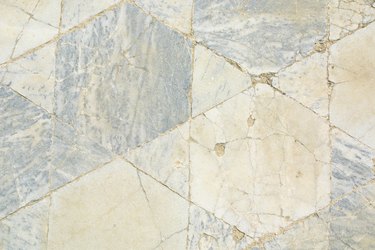
Damage to a subfloor is one of the most common reasons for a tile to bulge or lift from the subfloor, according to the American Society of Home Inspectors. Tiles need to adhere to a smooth, undamaged surface. The subfloor must be clean, even and dry before tile installation. Any low spots on the subfloor can cause a tile to bulge. Even a slight tile bulge presents a safety hazard over which people can trip. The bulging also allows more moisture to reach the subfloor, creating further damage.
Moisture
Video of the Day
Moisture can damage both the subfloor and tiles. Moisture that comes up from a crawl space can saturate the subfloor causing it to separate, mold and rot. This damage can push a tile out of alignment. A tile can also bulge if it absorbs moisture either from the subfloor damage caused from below or from repeated water spills. Even a small amount of water spilled onto the tile every day can cause rot and mildew on the subfloor below. An isolation membrane applied to the subfloor before tiling can prevent subfloor damage from spills.
Video of the Day
Cracks
Subfloors can crack due to building movement or improper installation. They can also crack when the amount of deflection, or bending in the subfloor, is too great. Too much bending in the subfloor may be caused by overloading or putting too much weight on the floor. Cement subfloors must be left to dry or cure for at least four weeks to prevent cracking. Any of these types of cracking can result in tile bulging.
Tiling Over Tiles
You can tile over an existing tile floor; however, you must check for subfloor and tile damage before retiling and replace any damaged subfloor areas and tiles. The old tiles must be clean and sanded to give the mortar for the new tiles a rough adhering surface. Floor patching compound can fill in any low spots in the old tile floor. However, the patched areas must be sanded before the floor can function as a subfloor for the new tiles.
Considerations
Putting down a new subfloor may solve the tile bulging problems if the old subfloor is too damaged to fix. It is important to follow all of the manufacturer's instructions when laying down a new subfloor to ensure that the new tile will not bulge. Check the spacing of nails and screws carefully. Plywood subfloors should be screwed into the floor joists with corrosion-resistant screws. Use the proper moisture membrane barrier for subfloors. Roofing felt may be less expensive; however, it will not provide your subfloor with enough protection.